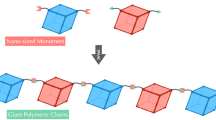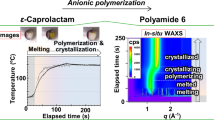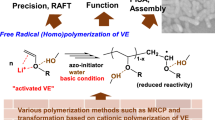Abstract
The N-heterocyclic carbene 1,3-di-tert-butylimidazol-2-ylidene (NHCtBu) and its 1:1 adduct with methyl sorbate (MS) were found to initiate anionic polymerization of N-substituted maleimides (RMIs) in organic solvents at −20 °C to afford linear and cyclic poly(RMI)s, respectively. Quantitative monomer consumption was observed when a bulky aluminum Lewis acid, such as methylaluminum bis(2,6-di-tert-butyl-4-methylphenoxide) (MAD), was used as an additive. In the presence of the NHCtBu:MS adduct as an initiator, monomer consumption was followed by ring closure without the need for highly diluted conditions to give cyclic poly(RMI)s containing α-terminal MS units, which exhibited an Mn of 3.4 × 103–6.2 × 103 and a broad polydispersity index (Mw/Mn = 2.43–2.65). Dilution was not required due to the presence of an α-terminal NHCtBu group, which acted as a counter cation for the propagating center during polymerization. The broad molecular weight distributions of the obtained polymers were ascribed to a chain transfer upon abstraction of the α-carbonyl proton of the RMIs, particularly to the neighboring NHCtBu cation unit. 1H NMR and matrix-assisted laser desorption/ionization time-of-flight (MALDI-TOF) mass analyses indicated that the proton transfer of the acidic proton was induced by the propagating anion. The topologies of the linear and cyclic poly(RMI)s were directly observed by transmission electron microscopy (TEM).
This is a preview of subscription content, access via your institution
Access options
Subscribe to this journal
Receive 12 print issues and online access
$259.00 per year
only $21.58 per issue
Buy this article
- Purchase on Springer Link
- Instant access to full article PDF
Prices may be subject to local taxes which are calculated during checkout











Similar content being viewed by others
References
Roovers J. In: Semlyen JA, editor. Cyclic polymers. 2nd ed. Dordrent: Kluwer Academic Publishers; 2000.
Clarson SJ, Dodgson K, Semyen JA. Studies of cyclic and linear poly(dimethylsiloxanes): 19. Glass transition temperatures and crystallization behaviour. Polymer. 1985;26:930–4.
Endo K. Synthesis and properties of cyclic polymers. Adv Polym Sci. 2008;217:121–83.
Deffieux A, Borsali R. In: Matyjazewski K, Gnanou Y, Liebler L, editors. Macromolecular engineering: precise synthesis, materials properties, applications. Weinheim: Wiley-VCH; 2007. Vol. 2, p. 875–908.
Lee W, et al. Retention behavior of linear and ring polystyrene at the chromatographic critical condition. Macromolecules. 2002;35:529–38.
Hosoi Y, Takasu A, Matsuoka S, Hayashi M. N-heterocyclic carbene initiated anionic polymerization of (E,E)-methyl sorbate and subsequent ring-closing to cyclic poly(alkyl sorbate). J Am Chem Soc. 2017;139:15005–12.
Matsuoka S, et al. Organocatalytic tail-to-tail dimerization of olefin: umpolung of methyl methacrylate mediated by N-heterocyclic carbene. Org Lett. 2011;13:3722–5.
Kato T, Ota Y, Matsuoka S, Takagi K, Suzuki M. Experimental mechanistic studies of the tail-to-tail dimerization of methyl methacrylate catalyzed by N-heterocyclic carbene. J Org Chem. 2013;78:8739–47. https://doi.org/10.1021/jo401477b
Kato T, Matsuoka S, Suzuki M. Cooperative N-heterocyclic carbene/bronsted acid catalysis for the tail-to-tail (Co)dimerization of methacrylonitrile. J Org Chem. 2014;79:4484–91.
Matsuoka S, Awano N, Nakazawa M, Suzuki M. Tail-to-tail dimerization and Rauhut-Currier reaction of disubstituted Michael acceptors catalyzed by N-heterocyclic carbene. Tetrahedron Lett. 2016;57:5707–11.
Matsuoka S, Fukumoto Y, Suzuki M. Tail-to-tail cross-dimerization of methyl methacrylate/methacrylonitrile with acrylates catalyzed by N-heterocyclic carbene. Chem Lett. 2017;46:983–6. https://doi.org/10.1246/cl.170263
Kawai H, Fukumoto A, Matsuoka S, Suzuki M. Enhanced activity of the tail-to-tail dimerization of Michael acceptors catalyzed by N-heterocyclic carbene and subsequent polymer synthesis from the resulting dimers. Chem Lett. 2019;48:558–61. https://doi.org/10.1246/cl.190097
Biju AT, Padmanaban M, Wurz NE, Glorius F. N-heterocyclic carbene catalyzed umpolung of Michael acceptors for intermolecular reactions. Angew Chem Int Ed. 2011;50:8412–5. https://doi.org/10.1002/anie.201103555
Schedler M, Wurz NE, Daniliuc CG, Glorius F. N-heterocyclic carbene catalyzed umpolung of styrenes: mechanistic elucidation and selective tail-to-tail dimerization. Org Lett. 2014;16:3134–7. https://doi.org/10.1021/ol501256d
Oga Y, Hosoi Y, Takasu A, Higuchi M. Synthesis of cyclic poly(methyl methacrylate) via N-heterocyclic carbene (NHC) initiated-anionic polymerization and subsequent ring-closing without need of highly dilute conditions. Polymer. 2020;186:122019.
Naruse K, Takasu A, Higuchi M. Direct observation of a cyclic vinyl polymer prepared by anionic polymerization using N-heterocyclic carbene and subsequent ring-closure without highly diluted conditions. Macromol Chem Phys. 2020;221:2000004.
Oishi T, Yamasaki H, Fujimoto M. Asymmetric polymerization of N-substituted maleimides. Polym J. 1991;23:795–804.
Onimura K, Tsutsumi H, Oishi T. Asymmetric polymerization of N-substituted maleimides with organolithium—bisoxazolines complex. Polym Bull. 1997;39:437–44.
Onimura K, Tsutsumi H, Oishi T. Asymmetric anionic polymerization of N-substituted maleimides with Et2Zn and chiral bisoxazolines. Chem Lett. 1998;27:791–2.
Onimura K, Tsutsumi H, Oishi T. Asymmetric anionic polymerization of N-substituted maleimides with n-butyllithiummethylene-bridged 2,2-bis(oxazoline) complexes. Macromolecules. 1998;31:5971–6.
Oishi T, Onimura K, Tanaka K, Horimoto W, Tsutsumi H. Asymmetric polymerization of N-substituted maleimides with chiral oxazolidine—organolithium. J Polym Sci Part A, Polym Chem. 1999;37:473–82.
Oishi T, Onimura K, Isobe Y, Tsutsumi H. First determination of absolute stereochemistry of N-naphthylmaleimide polymer. Chem Lett. 1999;28:673–4.
Oishi T, Onimura K, Isobe Y, Yanagihara H, Tsutsumi H. Asymmetric anionic polymerization of maleimides bearing bulky substituents. J Polym Sci Part A, Polym Chem. 2000;38:310–20.
Zhou H, Onimura K, Tsutsumi H, Oishi T. Asymmetric anionic polymerization of (R)-(+)-N-α-methylbenzylmaleimide with chiral ligand/organometal complex. Polym J. 2000;32:552–9.
Zhou H, Onimura K, Tsutsumi H, Oishi T. Synthesis and chiroptical properties of (S)-(-)-N-α-methylbenzylmaleimide polymers containing crystallinity. Polym J. 2001;33:227–35.
Isobe Y, Onimura K, Tsutsumi H, Oishi T. Asymmetric anionic polymerization of N-1-naphthylmaleimide with chiral ligand—organometal complexes in toluene. J Polym Sci Part A, Polym Chem. 2001;39:3556–65.
Isobe Y, Onimura K, Tsutsumi H, Oishi T. Asymmetric polymerization of N-1-naphthylmaleimide with chiral anionic initiator: preparation of highly optically active poly(N-1-naphthylmaleimide). Macromolecules. 2001;34:7617–23.
Onimura K, Zhang Y, Yagyu M, Oishi T. Asymmetric anionic polymerization of optically active N-1-cyclohexylethylmaleimide. J Polym Sci Part A, Polym Chem. 2004;42:4682–92.
Zhang Y, Onimura K, Tsutsumi H, Oishi T. Asymmetric anionic polymerization of (S)-(-)-N-maleoyl-L-valine methyl ester. Polym J. 2004;36:878–87.
Lee YK, Kitamura S, Onimura K, Tsutsumi H, Oishi T. Asymmetric polymerization of N-1-naphthylmaleimide with (R,R)-N,N-bis(3,5-di-tert-butylsalicylidene)-1,2- cyclohexanediaminatocobalt (II). J Polym Sci Part A, Polym Chem. 2004;42:6157–62.
Gao H, Isobe Y, Onimura K, Oishi T. Synthesis and polymerization of novel (S)-N-maleoyl-L-leucine propargyl ester. Polym J. 2006;38:1288–91.
Isobe Y, Onimura K, Tsutsumi H, Oishi T. Asymmetric polymerization of N-1-anthrylmaleimide with diethylzinc—chiral ligand complexes and optical resolution using the Polymer. Polym J. 2002;34:18–24.
Oishi T, Isobe Y, Onimura K, Tsutsumi H. Asymmetric polymerization of N-ortho- or para-substituted phenylmaleimide using chiral anionic initiators. Polym J. 2003;35:245–54.
Oishi T, Zhang Y, Fukushima T, Onimura K. Asymmetric anionic polymerizations of (R)-N-Maleoyl-D-phenylglycine alkyl esters and optical resolution using their. Polym J. 2005;37:453–63.
Gao H, Isobe Y, Onimura K, Oishi T. Synthesis and asymmetric polymerization of (S)-N-maleoyl-L-leucine propargyl ester. J Polym Sci Part A, Polym Chem. 2007;45:3722–38.
Gao H, Isobe Y, Onimura K, Oishi T. Asymmetric polymerization of (S)-N-maleoyl-L-leucine allyl ester and chiral recognition ability of its polymer as chiral stationary phase for HPLC. Polym J. 2007;39:764–76.
Azechi M, Toyota N, Yamabuki K, Onimura K, Oishi T. Anionic polymerization of N-substituted maleimide with achiral and chiral amines as an initiator. Polym Bull. 2004;67:631–40.
Enders D, Breuer K, Runsink J, Teles JH. Chemical reactions of the stable carbene 1,3,4-triphenyl-4,5-dihydro-1H-1,2,4-triazol-5-ylidene. Liebigs Ann. 1996;2019–28.
Matsuoka S, Tochigi Y, Takagi K, Suzuki M. Sequential one-pot and three-component reactions of an N-heterocyclic carbene to form 4-(1,2,4-triazol-5-ylidene)pyrrolidine-2,5-diones: a tandem umpolung/annulation sequence via deoxy-Breslow intermediates. Tetrahedron. 2012;68:9836–41.
Acknowledgements
AT is grateful for financial support from the Ministry of Education, Science and Culture of Japan (Grant-in-Aid for Development Scientific Research 18K19112 and 20H02786). We also acknowledge Dr. Mikihiro Hayashi for his continuous advice and encouragement.
Author information
Authors and Affiliations
Corresponding author
Ethics declarations
Conflict of interest
The authors declare that they have no conflict of interest.
Additional information
Publisher’s note Springer Nature remains neutral with regard to jurisdictional claims in published maps and institutional affiliations.
Supplementary information
Rights and permissions
About this article
Cite this article
Muramatsu, Y., Oga, Y., Takasu, A. et al. Direct observation of cyclic poly(N-substituted maleimide)s with broad size distributions synthesized by anionic polymerization using an N-heterocyclic carbene and successive ring closure without high dilutions. Polym J 52, 1253–1261 (2020). https://doi.org/10.1038/s41428-020-0384-z
Received:
Revised:
Accepted:
Published:
Issue Date:
DOI: https://doi.org/10.1038/s41428-020-0384-z
This article is cited by
-
Synthetic innovations for cyclic polymers
Polymer Journal (2022)



